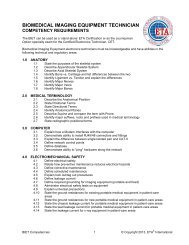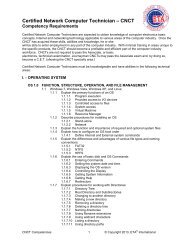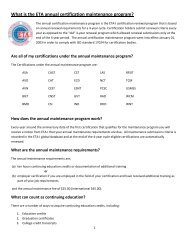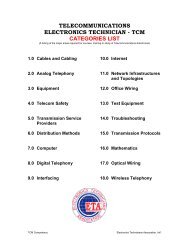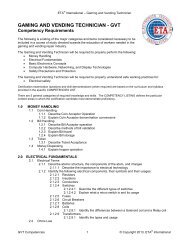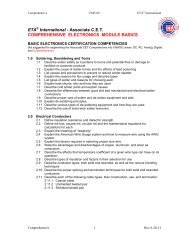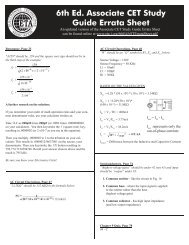You also want an ePaper? Increase the reach of your titles
YUMPU automatically turns print PDFs into web optimized ePapers that Google loves.
shows us its average over time:Eq. 4 dVout / dt = -Vin / RCwheredVout = change in output voltagedt = change in time in secondsMathematically, this is a bit complex, involvingdifferential calculus, but conceptually it’s simple. Think of a tank withwater in it. The water level depends on how fast water is flowing in or out,and how long that’s been going on. The water level corresponds to theoutput voltage.Again, a circuit without RF, a true integrator, isn’t practical. C is an opencircuit at DC, meaning there’s no DC feedback path to set the quiescent or“resting” output voltage, which will drift uncontrolled. With RF, there will bea corner frequency found by:Eq. 5 Fc = 1 / 2RfCBelow this frequency, the circuit approximatesa normal inverting amp. If its purpose is toattenuate high frequencies, it is called a lowpassfilter. The response curve is shown infigure 5B.DC Output Voltage ErrorsUp to this point, we have been ignoring the fact that real-world op-amps arenot perfect. In reality, the quiescent DC output voltage is never exactly whatit is supposed to be. There are three principal causes of this:• Input bias current• Input current offset• Input voltage offsetIn many circuits, this is of no importance. If we’re amplifying and processinghigh-frequency signals, there will be series capacitors in the circuit and DCoffsets will not be coupled from one part of the circuit to another. But inmeasurement and control applications, starting with the right DC voltage isoften critical. The problem is made worse by the fact that offset current andvoltage drift with time and changes in temperature.Let’s look at bias current first. Inmost op-amps, the inputs are internallyconnected to the bases of twobipolar junction transistors. BJTs requirea small amount of base currentto operate. This shows up as currentflowing out of the input connections(or into them, depending on the BJTs’ polarity) and through the associatedcircuitry. This is shown in figure 6A, which is a standard inverting amplifier.Note that the “+” input is connected to ground, while the “-“ input is connectedto two resistors. This means the voltage at “+” will be zero, while thevoltage at “-“ will not, because there will be voltage drop across the resistors.There is a voltage difference between the inputs, which will show up at theoutput magnified by the circuit’s gain.Figure 6B shows the most common wayto fix this. R3, inserted between the “+”input and ground, should have a resistanceequal to the parallel resistance ofR1 and R2. To be really accurate, theresistance of the signal source should befigured into the value of R1. This waythe voltage drop between the outputs and ground will be equal.We’re still not out of the woods. One of the virtues of the integrated circuitop-amp is that input voltage and current are automatically well matched –but they’re not perfectly matched. The input current imbalance, or offset,will cause differing voltage drops across the associated resistors. This problemand the previous one can be eliminated by using FET-input op-amps.The input current of a FET is essentially zero.We still have the input voltage offset to deal with. The easiest fix, though itwill only get us close, is to pay extra for factory-trimmed or selected op-amps.The second is to deliberately inject a tiny correction voltage into one of theinputs. This is drawn from the power supply, cut down by a voltage divider,and adjusted by a pot.The third is to buy an op-amp with extra terminals for connection to anoffset-trimming pot.The fourth and most complicated is to use a chopper-stabilized amplifier,which chops up the DC signal into AC, amplifies it, then integrates it back toa DC signal. This method has the advantage of automatically correcting fordrift, which is why choppers are often called zero-drift amplifiers.Gain, Frequency Response and StabilityAs stated in part 1, the DC gain of an op-amp is very high. However, there isalways some high frequency at which the phase shift of the op-amp becomesgreat enough to cause oscillation. If the op-amp is going to be usable as avoltage follower, with a circuit gain of unity, then its own gain must fall belowunity by the time it reaches that critical frequency.Figure 7 shows the gain-vs.-frequency behavior of the 741 op-amp. Its opencircuit gain is around 200,000, but already at 5Hz the gain is beginning tofall. It reaches unity gain at 1MHz.The usable frequency range in a circuitdepends on how much gain you’re goingfor. With a 741, if you want a voltagegain of 10,000, you’re only going to getit to 100Hz, because that’s all the gain a741 has at that frequency. On the otherhand, if you’re only going for 100X gain,the 741 is good to 10kHz. This is aconsideration that affects most op-ampcircuit designs.Op-amps are now available that will work into the hundreds of MHz. On theother hand, if we don’t need fast response, we can choose an op-amp that’smuch slower than a 741 and uses a tiny fraction of the power. In an applicationlike remote, solar-powered telemetry, this would extend battery life.Sine-Wave OscillatorsOp-amps have dozens of other uses; we’ll just mention this one. Feedback tothe “-“ input stabilizes the circuit. This kind of feedback is called “negativefeedback,” because it reduces gain. It also reduces error, which is to say ithas a stabilizing influence.Feedback to the “+” is called “positive feedback.” Any output voltagechange is further increased by positive feedback. In other words, positivefeedback has a destabilizing influence. The whole reason op-amp stability isan issue, as discussed above, is that phase shift can turn negative feedbackinto positive feedback at some frequencies.But in an oscillator, we don’t want stability. We want the circuit to go into aself-sustaining, oscillating mode, producing a continuous output waveform.On the other hand, we want a well-controlled waveform at a defined frequency.The easiest way to do that is to combine positive and negative feedback.The circuit in figure 8 is a form of sine-waveoscillator. The feedback circuit connectedto the “-“ input is a frequency-selectivenetwork. This particular arrangement iscalled a “Wein bridge.” The circuit connectedto the “+” input is a variable feedbacknetwork that gets things oscillating.Once an oscillator starts, it will run awaywith itself unless there’s some automatic stabilization network. This simpleone uses the variable resistance of an incandescent lamp. Nowadays, a FETwith a lot of circuitry attached is likely to take the place of the lamp.A lot more could be written about op-amps. If you have specific questions,forward them to <strong>ETA</strong>-I, and another article might result, either in HTN oronline. HTNJAN/FEB2010 | etainternational.org | 9



